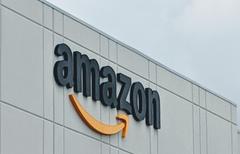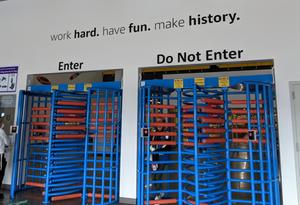 Yesterday on its front page, the New York Times ran a feature article that is one of the most comprehensive looks we've seen at the effects of Amazon on commerce and life in general in the U.S. The story offers a fresh take on what is familiar about Amazon's history in the past 25 years--its growing dominance of online retailing; its aggressive approach to competitors, suppliers, government and others; its brutal warehouse conditions; its anti-labor and anti-union policies; its push to avoid paying or collecting taxes, among other things. But in focusing on Amazon's presence and effect on one area--Baltimore, Md.--the Times story expands into new and unnerving territory, going into depth about Amazon's role in police surveillance; data collection; sports metrics; aggressive courting of government and school purchasing; the use of its cloud services by more and more companies, organizations, schools and governments; and its expansion of airplane and truck deliveries, causing more and more traffic congestion and pollution.
Yesterday on its front page, the New York Times ran a feature article that is one of the most comprehensive looks we've seen at the effects of Amazon on commerce and life in general in the U.S. The story offers a fresh take on what is familiar about Amazon's history in the past 25 years--its growing dominance of online retailing; its aggressive approach to competitors, suppliers, government and others; its brutal warehouse conditions; its anti-labor and anti-union policies; its push to avoid paying or collecting taxes, among other things. But in focusing on Amazon's presence and effect on one area--Baltimore, Md.--the Times story expands into new and unnerving territory, going into depth about Amazon's role in police surveillance; data collection; sports metrics; aggressive courting of government and school purchasing; the use of its cloud services by more and more companies, organizations, schools and governments; and its expansion of airplane and truck deliveries, causing more and more traffic congestion and pollution.
Called "Amazon Everywhere: Prime Mover: How Amazon Wove Itself into the Life of an American City," the story ends on a positive note--citing the role of independent bookstores in fighting back against the Amazonization of the country and quoting a local bookseller, Emma Snyder, owner of the Ivy Bookshop and Bird in Hand. The Times observed with surprise that Snyder's stores sell books at full retail price. She responded: "There's much more consciousness of supporting a bookstore and specifically not using Amazon. Part of what people don't like is that Amazon debases the value of things. We're commercial spaces, but we fundamentally exist to feed and nurture people's souls."
Among the story's many observations and facts:
 |
|
| Amazon warehouse entrance | |
In Baltimore, Amazon has two "mammoth warehouses, built with heavy government subsidies, operating on the sites of shuttered General Motors and Bethlehem Steel plants." The non-union jobs here pay less than half what the union jobs in those plants paid, and some 600 Amazon employees, most of whom are part-timers at the warehouses, receive food stamps from the state (although nowhere near the amount of "aid" that what may be the richest corporation in the world receives). Workers are tracked by computers and let go if they don't meet strict numbers. So far this year, one of the warehouses counted "40 head injuries and 109 foot injuries."
Amazon's own jet fleet ships more in and out of Baltimore-Washington International Airport than FedEx and UPS combined. And there's more to come, the Times wrote: "Workers are putting the final touches on a $36 million 200,000-square-foot building, financed with tax-exempt bonds, that will dwarf Amazon's current airport operations. There are bays for 93 tractor-trailers to load and unload at once." (The company's poor labor relations apparently extend to the pilots of its contractor planes; some pilots complain that their pay is below industry average and they're being forced to fly more than pilots at other airlines, jeopardizing safety.)
The related parts of Amazon's transportation network--which continues to expand in the push for the fastest deliveries possible--show signs of fraying and an anti-worker approach. Much delivery work is subcontracted or given piecemeal to independent drivers. At one package delivery station, "There are new SUVs, compacts with rooftop carriers and banged-up sedans. The drivers use the Amazon Flex app to sign up for 'blocks'--$54 for delivering a certain number of packages between 7 a.m. and 10 a.m. on one recent day, or $72 between 5:15 p.m. and 8:15 p.m."
Local professional football and baseball players' moves are tracked by microchips in their uniforms--in the case of the Ravens--and radar--for the Orioles, data that's sent to Amazon's cloud service for instant analysis using artificial intelligence.
Programs are moving forward to install Amazon Ring video cameras on homes in high-crime areas, whose images can be shared with the police instantly.
City government and Johns Hopkins University procurement officials are using Amazon Business to buy from local suppliers and others.
A year ago, Baltimore bid some $3.8 billion in subsidies to be chosen as a site for Amazon's "second headquarters." Though it didn't make the second round of bidding, the city turned over "reams of valuable work force and work site data to Amazon in elaborate applications--and got nothing in return."
More and more governments, businesses and organizations in the area are relying on Amazon Web Services, leading to "the steady conquest of the computing infrastructure that underlies commerce, government and communications, something like an electric utility--except without the regulation imposed on utilities," the Times wrote.
And, of course, at the same time, more and more bricks-and-mortar businesses have either contracted or closed because of Amazon. "As in other cities, many Baltimore shopping districts are anemic and pocked with vacancies," the Times noted. "The waterfront Harborplace shopping pavilions, once a symbol of urban revival, are in receivership." The article also shows how a variety of jobs and industries have been frayed by Amazon, cutting local employment and funneling money out of the area.
The Times quoted one tech entrepreneur, once a vocal fan of Amazon, who now "worries about Amazon's invasive data collection, the influence exercised by its algorithms, the heat generated by its enormous computer centers and the exploitation of its workers. 'It's a U.S. company that's hyperdominant and rich and has incredible market power, and they're not in it for social good,' he said."
He added: "'For my generation, the internet was the equivalent of landing on the moon. But the internet seems to have made some things so much worse. I'm not sure this is the world I want my kids to be growing up in."

